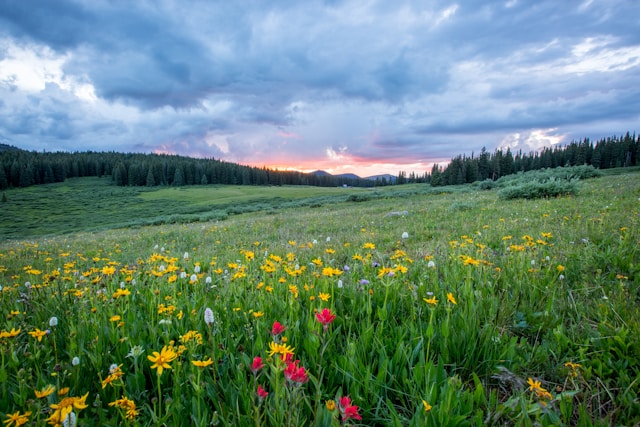Los beneficios de las plantas nativas en el diseño de su paisaje
What are native plants?
Native plants are those that occur naturally in a specific region without human intervention. These plants have evolved over thousands of years in a particular area, adapting to local climatic and soil conditions. This adaptation allows them to thrive with minimal maintenance, making them ideal for sustainable landscape design.
Importance of native plants in landscape design
Incorporating native plants into landscape design not only beautifies the environment, but also offers a number of ecological and practical benefits. These plants not only require fewer resources, but also help conserve biodiversity and create a natural balance in the ecosystem. This sustainable approach is not only beneficial for the environment, but also for those who enjoy a vibrant landscape full of life.
Adaptability and sustainability
Resistance to local climatic conditions
Native plants are perfectly adapted to local climatic conditions, meaning they can withstand the extreme temperatures, humidity variations, and other environmental conditions of their region. This adaptability reduces the need for additional watering and weather protection, which in turn decreases maintenance costs and time.
Reduced need for fertilizers and pesticides
Because native plants have evolved in harmony with their environment, they require less fertilizers and pesticides to stay healthy. This not only saves money and time, but also reduces the amount of chemicals introduced into the ecosystem, promoting a healthier environment for plants, animals and humans alike.
Water conservation
One of the biggest advantages of native plants is their ability to conserve water. These plants have developed mechanisms to make the most of the available water, making them ideal for gardens in water-scarce areas or for those looking to reduce their water consumption. Implementing native plants can help create a more sustainable and ecologically responsible landscape.
Benefits for biodiversity
Support for local fauna
Native plants provide food and shelter for local wildlife, including insects, birds and mammals. By growing native plants, you are contributing to the creation of a healthy habitat that supports local biodiversity. Pollinating insects, such as bees and butterflies, are especially dependent on these plants, which in turn benefits the entire ecosystem.
Pollination promotion
Native plants are crucial for pollination, as they attract local pollinators that have co-evolved with them. This process is vital for plant reproduction and the production of fruits and seeds. By encouraging the presence of pollinators through the use of native plants, you ensure better garden health and productivity.
Prevention of invasive species
Invasive species can be devastating to local ecosystems, as they compete with native plants for resources and often lack natural predators. By planting native species, you reduce the risk of invasive species establishing and thriving. Native plants can compete more effectively against these species, helping to maintain the natural balance of the ecosystem.
Aesthetic and design benefits
Variety of shapes, colors and textures
Native plants offer a wide variety of shapes, colors and textures, allowing for great flexibility and creativity in landscape design. From bright flowers and leafy shrubs to stately trees, native plants can satisfy a wide range of aesthetic preferences and design needs. This makes it easy to create visually attractive and unique landscapes.
Harmonious integration with the natural environment
Due to their adaptation to the local environment, native plants integrate more harmoniously with the surrounding natural landscape. This creates a cohesive and balanced design that appears to be a natural extension of the environment. Additionally, the use of native plants can help preserve and enhance the natural beauty of a region, maintaining the authenticity and character of the place.
Reduced maintenance and ease of care
One of the most significant advantages of using native plants is the low maintenance they require. These plants are adapted to thrive in local conditions without requiring intensive care, significantly reducing the time and effort required to maintain a healthy and attractive landscape. This makes them an ideal choice for those looking for a beautiful but low-maintenance garden.
Contribution to soil health
Improvement of soil structure
Native plants have root systems that are well adapted to improving soil structure in their natural environment. These roots can penetrate deep into the soil, helping to prevent erosion and improve water holding capacity. This not only benefits the plants themselves, but also contributes to the overall health of the soil and the sustainability of the landscape.
Increase in organic matter
As with any plant, the leaves and other debris of native plants decompose and become organic matter, enriching the soil. However, due to their specific adaptation, native plants are particularly effective in this process in their natural environment. This improves soil fertility and creates a more favorable environment for other plants and soil organisms.
Promotion of microbial life
Native plants have a symbiotic relationship with soil microorganisms, such as bacteria and fungi. These relationships are essential for soil health, as microorganisms help break down organic matter, recycle nutrients, and protect plants from disease. By growing native plants, you encourage soil rich in microbial life, contributing to a healthier, more balanced ecosystem.
Education and environmental awareness
Learning about local flora
Incorporating native plants into your landscape design offers an excellent opportunity to learn about local flora. This knowledge is not only valuable to the gardener, but can also be shared with the community, promoting a greater appreciation and understanding of native plants and their importance to the ecosystem.
Promotion of sustainable gardening practices
By using native plants, you are promoting sustainable gardening practices. These practices include water conservation, reducing the use of chemicals, and creating habitats for local wildlife. By sharing your experiences and knowledge with others, you can help spread these sustainable practices and contribute to the protection of the environment.
Promotion of respect for the environment
Using native plants in landscape design also encourages greater respect for the environment. By understanding and appreciating the importance of these plants, gardeners are more likely to adopt an attitude of conservation and protection towards the natural environment. This can have a lasting positive impact on the community and ecosystem at large.
Success stories and practical examples
Public gardens and parks that use native plants
Many public gardens and parks have adopted the use of native plants due to their numerous benefits. These spaces serve as inspiring examples of how native plants can be used to create beautiful, sustainable landscapes. By visiting these places, you can get ideas and motivation to apply in your own garden.
Ecological restoration projects
Ecological restoration projects often use native plants to restore and improve damaged ecosystems. These projects demonstrate how native plants can help restore biodiversity, improve soil health and provide habitats for local wildlife. Learning about these projects can offer valuable lessons and strategies to apply in your own landscape design.
Experiences of local gardeners
Hearing the experiences of other local gardeners who have incorporated native plants into their landscapes can be extremely helpful. These testimonials can provide practical information about which plants work best in your area, how to care for them, and any benefits they have seen. Participating in gardening groups or online forums can facilitate the exchange of knowledge and experiences.
Conclusion
The positive impact of native plants in your landscape
Incorporating native plants into your landscape design can have a significant positive impact on the environment, biodiversity and sustainability. These plants are not only aesthetically pleasing and easy to care for, but they also play a crucial role in preserving the local ecosystem. By choosing native plants, you are actively contributing to the health and beauty of your environment.
A call to action: Create a more sustainable and environmentally friendly garden
Creating a more sustainable and environmentally friendly garden is an achievable goal for any gardener. By opting for native plants, you are not only improving the sustainability of your own garden, but you are also helping to preserve biodiversity and protect the environment. We encourage you to explore the many native plant options available and begin integrating these valuable species into your landscape.









Deja una respuesta